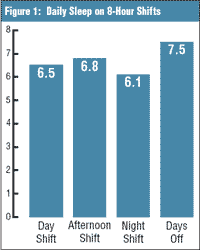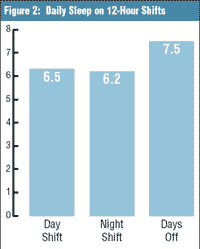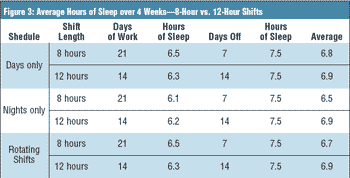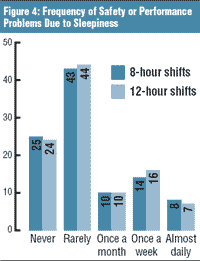Warding Off Sleepiness
Is your shift schedule depriving employees of their sleep?
- By Bruce Oliver, Jim Dillingham
- Mar 01, 2008

 Facilities that operate across multiple
shifts face a significant challenge when
it comes to maintaining the alertness of
their employees. According to the
National Sleep Foundation, “Sleep deprivation
is greatest among shiftworkers, who
average only 6.5 hours of sleep compared
to 6.8 hours for people on regular ‘9 to 5’
work schedules and 6.9 hours for all
respondents. . . . Shift workers are more
likely to suffer from insomnia as well as
excessive daytime sleepiness. They are also
more likely to drive while fatigued and
almost twice as likely to fall asleep at the
wheel.” This is a serious issue for management
because the lack of sleep or poorquality
sleep can lead to accidents, injuries,
absenteeism, and lower productivity.
Facilities that operate across multiple
shifts face a significant challenge when
it comes to maintaining the alertness of
their employees. According to the
National Sleep Foundation, “Sleep deprivation
is greatest among shiftworkers, who
average only 6.5 hours of sleep compared
to 6.8 hours for people on regular ‘9 to 5’
work schedules and 6.9 hours for all
respondents. . . . Shift workers are more
likely to suffer from insomnia as well as
excessive daytime sleepiness. They are also
more likely to drive while fatigued and
almost twice as likely to fall asleep at the
wheel.” This is a serious issue for management
because the lack of sleep or poorquality
sleep can lead to accidents, injuries,
absenteeism, and lower productivity.
Although most managers are aware
that shiftworkers don’t sleep as well as
other employees, few understand how
their organizations’ shift schedules contribute
to the problem. In this article, we
examine three major shift schedule attributes
that affect employee sleep: (1) shift
length, (2) fixed vs. rotating shifts, and (3)
shift start times. The data comes primarily
from our proprietary database of
employee surveys conducted with more
than 20,000 shiftworkers.
Shift Length
When we compare the survey results of
people working eight-hour shifts with
those working 12-hour shifts, we can see
how shift length affects the amount of
sleep that shiftworkers get. The average
daily hours of sleep for people working
eight-hour shifts are shown in Figure 1.
The average daily hours of sleep for
people working 12-hour shifts are shown
in Figure 2.
 At first glance, it appears the people
working 12-hour shifts get less sleep than
those on eight-hour shifts. But this is not
the case over a span of several days or
weeks because 12-hour shifts provide twice
as many days off, and employees sleep
longer on their days off. Figure 3 shows
the average hours of sleep during a fourweek
period. Regardless whether you
compare people working day shifts only,
night shifts only, or a rotating shift
schedule, the average hours of sleep during
the four-week period is greater on 12s.
At first glance, it appears the people
working 12-hour shifts get less sleep than
those on eight-hour shifts. But this is not
the case over a span of several days or
weeks because 12-hour shifts provide twice
as many days off, and employees sleep
longer on their days off. Figure 3 shows
the average hours of sleep during a fourweek
period. Regardless whether you
compare people working day shifts only,
night shifts only, or a rotating shift
schedule, the average hours of sleep during
the four-week period is greater on 12s.
A number of articles have been written
about safety risks with eight-hour shifts
vs. 12-hour shifts. The results are mixed.
Although our shiftworker surveys rely on
self-reported safety problems rather than
documented incidents, the survey results
suggest longer shifts are just as safe as
eight-hour shifts, as shown in Figure 4.
 Fixed vs. Rotating Shifts
Fixed vs. Rotating Shifts
When we compare the survey results of
people working rotating shifts with those
working fixed or “steady” shifts, we can
see how this schedule attribute affects
sleep. As seen in Figure 5, people working
a rotating shift schedule average roughly
the same amount of sleep during a fourweek
period as people working a fixed
night shift schedule. They get less sleep
than people working a fixed day shift or
fixed afternoon shift.
In addition to improved predictability,
fixed shifts allow shiftworkers to sleep at
approximately the same time each day.
This avoids the physical stress (and poorquality
sleep) most people experience
when they adjust their circadian rhythm
to a new sleep period with each rotation.
This benefit is realized by those working
fixed day, evening, and voluntary night
shifts. Unfortunately, many people
assigned to work on a fixed night shift try
to rotate back to a day routine on their
days off, mitigating some of this benefit.
With regard to safety or performance
problems due to sleepiness, Figure 6
shows that workers on rotating shifts
report problems more frequently than
workers on fixed shifts.
Impact at an Auto Manufacturing Plant

A large auto manufacturing plant we
worked with had two different schedules
that were an hour apart. Three-quarters
of the workers on day shift started work
at 6:30 a.m. The rest started an hour
later. When surveyed, employees with
the later starting time said they got an
average of 34 minutes more sleep on the
days they worked than did the employees with the early start time. Employees with
the earlier start time did not go to sleep
earlier, probably because of personal,
family, or social activities. On their days
off, both groups got about the same
amount of sleep.
 The later start times had mixed results
with the afternoon and night shifts at the
plant. As seen in Figure 6, the afternoon
shift with late start times got a little more
sleep and the night shift with late start
times got less sleep. The day shift experienced
the most significant change.
The later start times had mixed results
with the afternoon and night shifts at the
plant. As seen in Figure 6, the afternoon
shift with late start times got a little more
sleep and the night shift with late start
times got less sleep. The day shift experienced
the most significant change.
Asked how often they had problems
with safety or performance due to sleepiness,
the group with the later starting time
reported they had frequent problems 31
percent less often than the employees on
the earlier day shift. In addition, the “later
starters” accounted for only 14 percent of
the reported accidents during a one-year
period despite representing 24 percent of
the total workers.
This is not an isolated case. The
National Institute for Occupational
Safety and Health (NIOSH) and the
Finnish Institute of Occupational Health
found that a one-hour delay in morning
shift start times at a steel mill increased
worker sleep and improved waking alertness
during the shift. They concluded
sleep was truncated when workers have
early start times because of family and
social activities in the evenings. They
found the evening and night shifts were
affected negatively by starting work later;
however, the results were less consistent
across all measures.

Summary
This article focused on the sleep effects of
three schedule attributes. Ideally, business
requirements and employee preferences
also will be taken into account when
selecting the “best” shift schedule for
your site.
This article originally appeared in the March 2008 issue of Occupational Health & Safety.